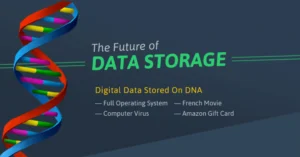Introduction
In today’s age, the challenge of data storage has grown exponentially. As our reliance on technology and the creation of data continues to escalate, traditional storage solutions are being pushed to their limits. However, an exciting breakthrough has emerged as a potential solution to this crisis: DNA. Yes, the very building blocks that make up our genetic code could hold the key to revolutionizing data storage as we know it.

DNA as a Data Storage Medium
At its core, DNA (deoxyribonucleic acid) is a complex molecule that contains the genetic instructions for all living organisms. Its unique structure, consisting of a double helix formed by four nucleotide bases (adenine, thymine, cytosine, and guanine), makes it an ideal candidate for storing vast amounts of digital information. The information-carrying capacity of DNA is staggering, with just one gram capable of holding approximately 215 petabytes (1 petabyte = 1 million gigabytes) of data.
Furthermore, DNA possesses exceptional stability and longevity. Natural processes like DNA replication and repair mechanisms ensure the integrity of the information stored within the molecule. Scientists have successfully extracted DNA from ancient bones and preserved it for thousands of years. This remarkable stability makes DNA an attractive storage medium for long-term data preservation.
Encoding Data into DNA
The four-letter code of DNA, analogous to the binary code used in computing, serves as the foundation for encoding data into this biological medium. By translating bits of information into DNA’s four bases, digital data can be represented and stored within the DNA structure. Techniques such as DNA synthesis allow scientists to artificially create DNA molecules precisely tailored to carry specific data.
Error correction and redundancy play crucial roles in ensuring the accuracy and integrity of DNA data storage. Just as digital data undergoes error correction techniques, such as checksums and redundancy check bits, DNA data storage incorporates similar mechanisms to maintain data fidelity.
Retrieving and Reading DNA Data
Sequencing technologies have revolutionized our ability to retrieve and read DNA-encoded data. High-throughput sequencing techniques, such as Next-Generation Sequencing (NGS), enable the efficient and rapid decoding of vast amounts of DNA information. Bioinformatics tools, powered by advanced algorithms and computational methods, aid in the analysis and interpretation of DNA-encoded data.
Nevertheless, challenges persist in the retrieval process. While sequencing technologies have made significant advancements, they still face limitations in terms of cost, speed, and scalability. Researchers continue to explore innovative solutions to overcome these hurdles and unlock the full potential of DNA storage.
Advantages and Challenges
DNA data storage offers several advantages that make it stand out from traditional data storage methods. The data density and storage capacity of DNA are unmatched, far exceeding any existing technology. The ability to store immense amounts of data in a minuscule amount of physical space presents a game-changing advantage.
Furthermore, DNA data storage is remarkably energy-efficient, requiring minimal power and reducing the overall environmental impact of data centers. This ecological aspect aligns well with our increasing focus on sustainable technologies.
However, DNA data storage is not without challenges. Technological hurdles, such as the high cost of DNA synthesis and sequencing, limit its widespread implementation. Additionally, ensuring the security and privacy of DNA-encoded data raises ethical concerns. Striking a balance between technological advancements and responsible use is crucial for the future of DNA data storage.
Real-world Applications
The potential applications of DNA data storage are vast and span various sectors. Archival storage and long-term preservation benefit greatly from DNA’s stability and longevity. Preserving cultural and historical heritage through the encoding of important documents and artifacts in DNA ensures their safekeeping for future generations.
In extreme environments, such as space exploration missions, where traditional data storage is impractical, DNA data storage offers a reliable solution. The robustness of DNA against harsh conditions makes it capable of preserving data under extreme circumstances.
Moreover, the healthcare and research fields hold immense potential for DNA data storage. Storing vast amounts of genomic and medical data in DNA could fuel breakthroughs in personalized medicine and advance our understanding of various diseases.
Future Prospects
The future of DNA data storage is ripe with endless possibilities. Ongoing innovations in DNA synthesis and sequencing technologies are paving the way for even more efficient and cost-effective solutions. Moreover, integrating DNA data storage with emerging technologies like artificial intelligence (AI) and nanotechnology could unlock new frontiers in data processing and manipulation.
Scaling up DNA data storage to commercial viability remains a significant objective. Establishing regulatory frameworks and standardization protocols will be crucial in ensuring the safe and responsible implementation of this technology.
Ethical and Societal Implications
As with any emerging technology, DNA data storage brings forth ethical and societal implications. Questions surrounding ownership and control of DNA-encoded data must be carefully addressed to prevent potential misuse or exploitation. Ensuring robust biosecurity measures will be vital in mitigating the risks of bioterrorism or unauthorized access to sensitive genetic data.
On the other hand, DNA data storage also offers opportunities for cultural and historical preservation. By encoding valuable cultural heritage into DNA, we can safeguard it for future generations, transcending the limitations of traditional archiving methods.
Conclusion
DNA data storage represents a revolutionary leap forward in the realm of data storage. Its potential to store vast amounts of information in a compact, stable, and long-lasting medium has captivated researchers and scientists alike. However, responsible progress and considerations for ethical implications are essential to ensure the safe and accountable implementation of this groundbreaking technology. As we envision a future where DNA encodes our digital heritage, we must tread carefully, striking a balance between technological advancement and responsible use.